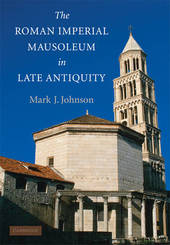
|
The Roman Imperial Mausoleum in Late Antiquity
Hardback
Main Details
| Title |
The Roman Imperial Mausoleum in Late Antiquity
|
| Authors and Contributors |
By (author) Mark J. Johnson
|
| Physical Properties |
| Format:Hardback | | Pages:330 | | Dimensions(mm): Height 262,Width 186 |
|
| Category/Genre | Ancient and classical art BCE to c 500 CE |
|---|
| ISBN/Barcode |
9780521513715
|
| Classifications | Dewey:709.450901 |
|---|
| Audience | | Professional & Vocational | |
|---|
|
Publishing Details |
| Publisher |
Cambridge University Press
|
| Imprint |
Cambridge University Press
|
| Publication Date |
29 May 2009 |
| Publication Country |
United Kingdom
|
Description
This book is the first comprehensive study of the mausolea of the later Roman emperors. Constructed between c.AD 244 and 450 and bridging the transition from paganism to Christianity within the empire, these important buildings shared a common design, that of domed rotunda. Mark Johnson examines the symbolism and function of the mausolea, demonstrating for the first time that these monuments served as temples and shrines to the divinized emperors. Through an examination of literary sources and the archaeological record, he identifies which buildings were built as imperial tombs. Each building is examined to determine its place in the development of the type as well as for its unique features within the group. Recognizing the strong relationship between the mausolea built for pagan and Christian emperors, Johnson also analyzes their important differences.
Author Biography
Mark Johnson is Professor of Art History at Brigham Young University. A scholar of ancient and Early Christian and Byzantine architecture, he has published in Dumbarton Oaks Papers, Gesta, Byzantion, and the Journal of Early Christian Studies, among other journals.
Reviews'Mark Johnson's book offers a valuable and up-to-date survey of extant and otherwise attested Roman imperial mausolea from Augustus to Honorius. This accessible and informative study should be the first stop for scholars and students interested in pursuing further analysis of Late Roman imperial funerary monuments.' American Journal of Archaeology
|